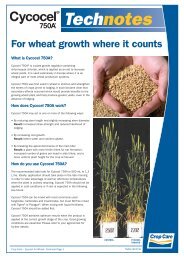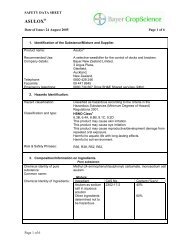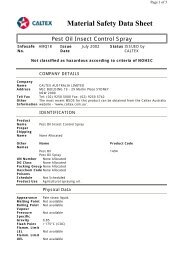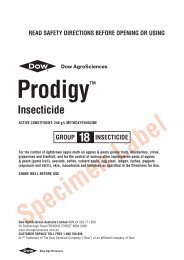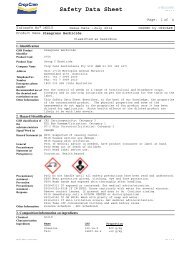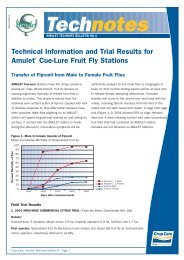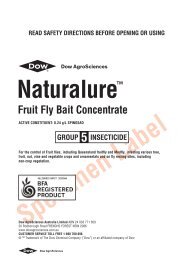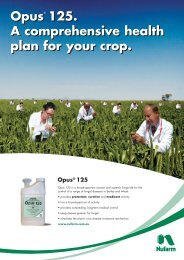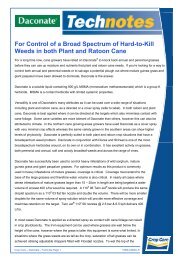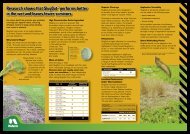Fastac Duo Technical Manual - Pest Genie
Fastac Duo Technical Manual - Pest Genie
Fastac Duo Technical Manual - Pest Genie
Create successful ePaper yourself
Turn your PDF publications into a flip-book with our unique Google optimized e-Paper software.
SOUTHERN ARMYWORM<br />
(Persectania ewingii)<br />
COMMON ARMYWORM<br />
(Mythimna convecta)<br />
- Cereal crops<br />
Cereal crops, especially oats and barley, are an<br />
attractive source of food for several insect pests.<br />
A rm y w o rm (barley grub) is the most destructive<br />
insect pest of these crops in Eastern and We s t e rn<br />
A u s t r a l i a .<br />
The severity of outbreaks varies from year to year<br />
and district to district. Armyworm generally inflicts<br />
greatest damage to cereal crops during November<br />
or December when it “chases” moisture in the<br />
maturing crops and lops off heads. Substantial<br />
grain losses can result if the pest is not identified<br />
and controlled promptly.<br />
Common<br />
armyworm<br />
larvae<br />
NEW Rate:<br />
240 mL/ha<br />
WHP reduced:<br />
7 days har v e s t<br />
14 days stubble<br />
g r a z i n g<br />
The adult is a dark grey,<br />
night-flying moth with a<br />
wing span of 2 to 3 cm,<br />
and is normally seen<br />
during September and<br />
O c t o b e r. A rm y w o rm<br />
can be distinguished<br />
from other moths by<br />
white streaks near the<br />
leading edge of the<br />
forewing and white<br />
lines near the far end of<br />
the forewing.<br />
adult<br />
In pastures they may cause total loss of vegetation<br />
when moving as an army (normally early summer).<br />
In barley and oats, up to 70-80% grain loss may<br />
result from severe infestations over a five day period.<br />
The moth lays eggs on grasses and cereal crops<br />
which hatch a week or two later, depending on<br />
weather conditions. Arm y w o rms have three or four<br />
life cycles per year in cool wet areas. They survive<br />
over summer on self-sown cereals and grasses<br />
which germinate with summer rains.<br />
In spring it takes about three weeks from when the<br />
eggs are laid for them to hatch and for the<br />
caterpillars to reach head-lopping size. The larvae<br />
when first hatched, are small pale caterpillars<br />
approximately 2mm long which change colour<br />
when feeding commences. They may feed for a<br />
week before causing economic damage. When<br />
mature, the grubs, may vary in colour from green<br />
to brown. Growing to 4 cm in length, they can be<br />
distinguished by three white stripes on the collar<br />
(behind head). The tail piece is always brown with<br />
three white longitudinal stripes.<br />
The presence of grubs is indicated<br />
by pale yellow/green pellets<br />
h a p e d-droppings known as<br />
“frass” which can be found on the<br />
ground in the crop. Awns and<br />
other flowering parts are often<br />
found around or near frass. A<br />
sweep net or bucket can be used to sweep through<br />
the heads of the crop to assess grub numbers. In<br />
some situations, larvae lop heads at night, and may<br />
r e t u rn to the soil during the day. In these situations,<br />
assess the level of damage already caused to the<br />
crop, and the days to harvest and base a spray<br />
decision on this.<br />
photo © NSW Agriculture<br />
The Solution<br />
Apply FA S TAC <strong>Duo</strong> at the label rate when<br />
sampling reveals 2 or more grubs per m 2 .<br />
One grub can cut off up to eight heads per night<br />
and therefore spraying should always occur<br />
when grubs are small and before head lopping<br />
c o m m e n c e s .<br />
Caterpillars are most active in cooler times of<br />
d a y. Spraying early morning or later aftern o o n<br />
will provide greatest knockdown.<br />
1 5<br />
FA S TAC DUO



